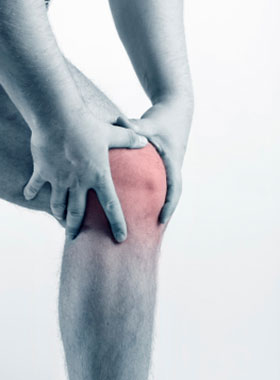5 Exercises to Best Strengthen the Knees
 This blog was originally posted on the American Council on Exercise website.
This blog was originally posted on the American Council on Exercise website.
The knees are one of the most complex and commonly misunderstood joints in the body (second only to the shoulders). Given that they bear approximately 80% of our bodyweight when we’re standing, the knees are highly susceptible to damage and the pain that often comes with it.
So it’s understandable that so many ask, “how can I strengthen my knees?” In order to answer this common question, we need to revisit the murky and potentially confusing depths of anatomy.
The knee joint consists of a complicated assortment of several bones, joints, ligaments, tendons – all of which provide the structural framework of the knee joint. In order to strengthen a particular area of the body (in this case, the knee), we need to focus on the muscular component of the joint. Fortunately, there are muscles around the knee – the muscles of the hip, thigh, and lower leg.
The knee joint is surrounded by:
- The large thigh muscle in the front of the leg (the quadriceps muscles).
- The equally large muscle on the back of the leg (the hamstring muscles).
- The muscle on the back part of the lower leg (the calf muscles).
- A long band of connective tissue that stretches from the hip bone, running alongside the outside of the thigh, down to the outside of the knee (the IT band).
While we can’t technically strengthen the knee joint, we can strengthen and stretch the surrounding muscles (the quadriceps, hamstrings, and calf muscles), and stretch the connective tissue that supports it (the IT band). Use the following five simple leg exercises to begin your lower-body strengthening program:
Muscle / Connective Tissue |
Exercise |
Quadriceps |
Bodyweight Squat |
Hamstrings |
Stability Ball Hamstring Curl |
Calves |
Barbell Calf Raises |
Hips |
Glute Bridge |
Illiotibial (IT) Band |
IT Band Stretch |
But what if you are already experiencing knee discomfort and want to prevent or minimize pain or injury in the future? Follow these three simple tips:
- Drink plenty of water each day (at least half of your body weight in ounces). Water will help provide cushioning to your joints which will help reduce pain.
- Make sure your sneakers have plenty of support in them. Old shoes are notorious for causing or exacerbating existing knee pain.
- Try to avoid or minimize exercises that place a high amount of stress on the knee joint, such as the leg extension.
While the above mentioned exercises can’t prevent you from ever experiencing knee pain in the future, an aggressive knee-pain prevention program can decrease your chances of injuring — or reinjuring — knees that are already damaged. With the right precautions now, you can continue living an active life for years to come.
For more articles like from ACE, go to The American Counsel on Exercise.




